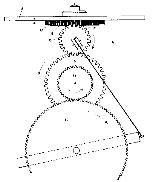Both modifications will increasing friction, thus steadying the pointer on rough terrain.
(click for details)

| Mr. Moule proposed the complex arrangement given to the right to satisfy
the specification given in the Sung Shih.
Keeping the principle of Yen Su, two more axles (wheels B and F/G in the
picture) are added, which keep the direction of rotation unaltered, but
facilitate changes in (a) rotational speed and (b) pitch. While (a) could
improve the accuracy - now more revolutions of the road wheels are available
before the small cogwheels disengage again - (b) will certainly take some
play out of the train.
Both modifications will increasing friction, thus steadying the pointer on rough terrain. |
(click for details)

|